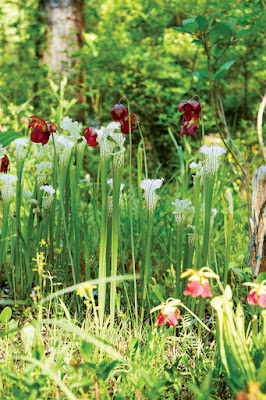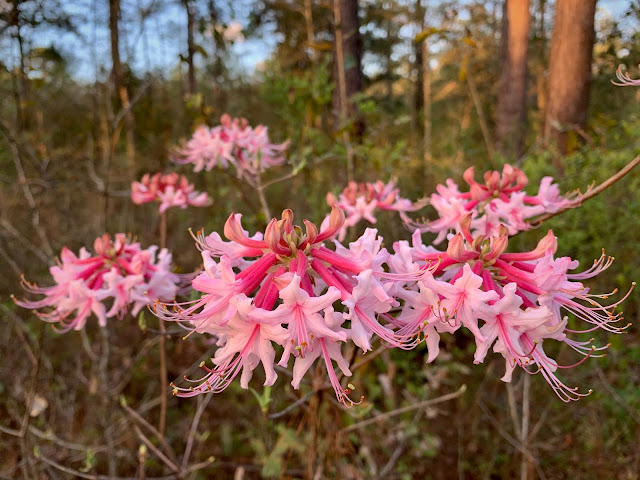Northern Alabama: Discovering Natives with our Neighbors
Submitted by Devon
Higginbotham
Devon's quest to find a
stateside location for an FNPS Native Plant Tour, brought her and her husband
to North Alabama, where they found the natural areas and plants to be as
diverse as anywhere in Florida, and the people just as dedicated to preserving them.
You too can discover our native plant neighbors on the FNPS NORTH ALABAMA NATIVE PLANT TOUR, APRIL 17 – 22ND, 2017.
Though I’ve travelled
throughout the United States, it never seems to be enough. The United
States is so huge, and every state and region has its own unique features;
sugar white beaches, rocky cliffs, huge peaked mountains, rolling hills,
prairies and alpine meadows. Every state is diverse, and each
season brings different wildflowers and foliage. Spring is nothing like fall,
winter or summer. Newly emerging leaves in spring are translucent,
ephemeral, pale green. Fall evolves to the crisp oranges, reds and
yellows. I want to see it all……over and over.
 |
| Pitcher Plants, Kaul Wildflower Garden |
Last October, my husband
and I set off “to see what we could see”. We had never spent much time in
north Alabama, but it was a day’s drive away and far enough north to support
different plant communities than Florida. In anticipation, we poured
through magazines, websites and joined the Alabama Wildflower Society
(AWS), the Alabama equivalent of our Florida Native Plant Society.
Then we found Linda.
Actually, I think, Linda found us; two lost souls wandering through the Alabama
Wildflower Society website. You see, Linda has been involved in the AWS
for quite some time and she was thrilled to hear that some of the Florida
members are interested in her state. We became fast friends, just over the
phone. But that’s the south, where everyone is “Darlin” and no one is a
stranger even if you just met, especially if you are another native plant
lover. The world does not know more welcoming people than native plant
people!
When we arrived in
Birmingham, Linda was waiting for us, along with about 20 other local native
plant enthusiasts. You see, she had already contacted the native plant
members in her area and they were ready and eager to showcase their state.
Marty Shulman, the
retired Land Manager of Ruffner Mountain Nature Preserve, explained
how Birmingham became one of the top steel producing regions in the country, first
utilizing Longleaf Pines for the process, then moving on to coal, just as the
pines were nearly depleted. Iron ore, coal and limestone are the three
ingredients needed to make steel and central Alabama has all three. Thus,
explains the 56-foot-tall cast iron statue of Vulcan, the Roman God of fire and
forge, in the center of Birmingham.
 |
| Bibb County Glades Preserve |
Charles Yeager, Manager
of Turkey Creek Nature Preserve, in the heart of the Birmingham, explained
how this inter-city preserve had been abandoned by all and utilized by gangs
who drove their cars into the river to wash them. When the land was at
its bleakest point, the city proposed building a prison on the site. But to the
local residents, this was the last straw. They rose up, banded together and
demanded the city preserve it. Today, it is a beautiful urban renewal
project, much loved and used by the local residents.
While visiting the Birmingham Botanical Gardens we met John Manion, Curator of the Kaul Wildflower Garden, a 17-acre garden within the main Garden. John is
the charming personality who created the native plant studies program at the
Gardens. He also manages one of the world’s rarest plants, the
Tutwiler’s spleenwort, Asplenium tutwilerae, a fern so rare that
less than 5 acres of land hold the only known population in the world.
As we ventured north
from Birmingham, the terrain became more rugged, sporting steep canyons with
gorges sliced by rivers and streams. We climbed the mountain in Cheaha State Park, the highest point in Alabama.
 |
| Jim & Fy Lacefield, Cane Creek Canyon Preserve |
Linda set up a meeting
with more locals, like Jim and Fay Lacefield, two school teachers who saved
their own salaries and bit-by-bit bought up 700 acres of canyon land with
coursing streams, then, gave it away! In perpetuity, Cane Creek Canyon Preserve will remain a wilderness area protected by The Nature
Conservancy, thanks to two people who had the love and foresight to preserve
it.
On to Huntsville where
the US Space and Rocket Center is located, the sister facility to Cape
Canaveral, and Wheeler National Wildlife Refuge, a 37,000 acre preserve for
migrating birds, established by FD Roosevelt.
 |
| Cathedral Caverns State Park |
Just to the east is
Scottsboro and underground is one of the most beautiful caverns in the United
States. Cathedral Caverns State Park has some of the largest
chambers in a cave system that I’ve ever seen. One stalagmite is the size
of a school bus and bears witness to the earthquakes the region has recently
endured.
As we fanned over to the northeast corner of the state we crossed a national preserve, part of the US National Park System. Cousin to our western parks, and equally impressive, the LittleRiver Canyon National Preserve sports a river flowing atop a mountain. The steep canyon walls, appropriately named "Little River", are the most extensive canyon and gorge system in the eastern United States, and habitat for the carnivorous green pitcher plant and Kral’s water plantains.
As we fanned over to the northeast corner of the state we crossed a national preserve, part of the US National Park System. Cousin to our western parks, and equally impressive, the LittleRiver Canyon National Preserve sports a river flowing atop a mountain. The steep canyon walls, appropriately named "Little River", are the most extensive canyon and gorge system in the eastern United States, and habitat for the carnivorous green pitcher plant and Kral’s water plantains.
If this intrigues you, stop dreaming, and join FNPS on a tour of Northern Alabama, April 17-22nd. We will learn more about Alabama native plants, meet
the local native plant enthusiasts, learn what inspires them, and discover
a world beyond Florida’s borders. Plan to meet Linda and
other members of the Alabama Wildflower Society, walk the woods of a
Benedictine Abbey, and seek out native trilliums and wild orchids. Check out the itinerary, register, mark your calendar and pack your bags for north Alabama! For questions,
call Devon at 813-478-1183.



Comments